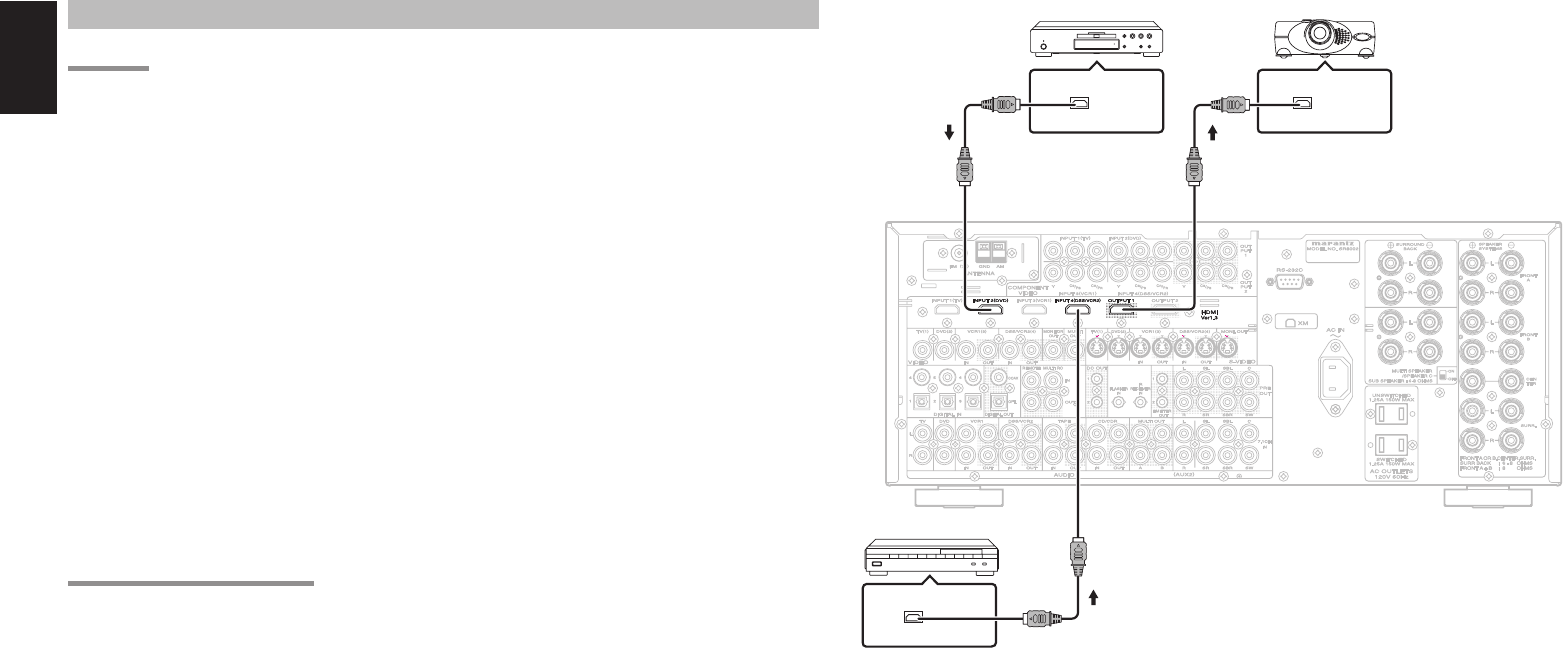
ENGLISH
34
HDMI JACK
This unit has four HDMI inputs and two HDMI output.
It can send digital video and audio signals from DVDs
and other sources directly to a display. It minimizes
signal degradation caused by analog conversion so
that high quality images can be enjoyed.
This unit is also capable of converting analog video
signals (Composite Video, S-Video, Component
Video) for HDMI output.
Select an input source from the OSD menu system.
(See page 43, 44)
Notes:
• When the HDMI output is connected to a display
monitor that does not support HDCP, signals are not
output. To view images in HDMI, it is necessary to
connect to a display that supports HDCP.
• There may be no image output if connected to a
TV or display that is not compatible with the above
format.
• Refer to the instruction manual of the TV or display
to be connected to the unit for detailed information
regarding the HDMI terminal.
* HDCP: High-bandwidth Digital Content Protection
CONNECTING HDMI COMPONENTS
An HDMI cable (sold separately) is used to connect
the HDMI jack on the unit with the HDMI jack on a DVD
player, TV, projector or other component. To transmit
multichannel audio via HDMI, the connected player
must support multichannel audio transmission through
its HDMI jack.
HDMI video streaming is compatible with DVI in
principle. Therefore, it is possible to connect to a TV
or monitor that has a DVI terminal using an HDMI-DVI
conversion cable or plug. When connecting to a DVI
terminal, connect the audio signal separately.
Notes:
• Some HDMI components can be controlled over
the HDMI cable, but this unit cannot control other
components this way.
• When connected to a monitor (i.e., TV, projector,
etc.) that does not support HDCP, video and audio
are not output.
• DVI cables come with 24-pin and 29-pin plugs. This
unit supports 24-pin DVI-D cables; 29-pin DVI
cables cannot connect to it.
DVD player VIDEO PROJECTOR
• Some source devices such as DVD players or set
top box do not support HDMI repeater operations
like those of the unit. In such case, pictures are not
properly projected on monitors such as TVs and
projectors.
• When multiple components are connected to this
unit, turn power to unused components off to
prevent interference between them.
• Disconnecting or connecting cables with the power
on can damage the equipment. Turn the power off
before disconnecting or connecting cables.
• Some DVD-Audio disks disable downmixing.
These types of disks are not played back correctly
unless the left, center, right and surround left and
right speakers, and subwoofer are connected.
• If a DVD player that does not support HDMI 1.1 or
later is connected to the unit, multi channel PCM
playback is not possible even with DVD-Audio
disks.
• If an Super Audio CD player that does not support
HDMI 1.2 or later is connected to the unit, DSD
playback is not possible even with Super Audio
CD.
(*DSD: Direct Stream Digital)
• The following functions are not available when the
unit is connected to equipment that does not support
HDMI 1.3a.
• Deep Color
• xvYCC
• Bitstream audio signal decoding, as for Dolby
Digital Plus, Dolby TrueHD, DTS-HD, and so on
For details, refer to the user’s manuals of connected
equipment.
• If a DVD player or other device with DVI output is
connected to the unit, a separate audio cable (optical-
digital, coaxial digital or analog) is needed for the
audio signals. In this case, select the connected audio
input as explained in “1-1 FUNC INPUT SETUP”.
(See page 43)
• Multi channel PCM signals and audio signals of 64
kHz or higher that are input from the HDMI jack are
not output from the DIGITAL OUT jacks.
• Depending on the quiality of the cable used, the
HDMI signal may be affected by noise.
HDMI OUTPUT HDMI INPUT
HDMI OUTPUT
SATELLITE TUNER
CONNECTING HDMI COMPONENTS


















